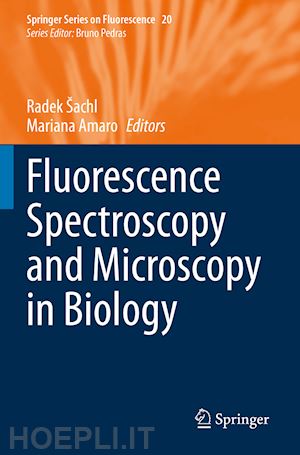
Questo prodotto usufruisce delle SPEDIZIONI GRATIS
selezionando l'opzione Corriere Veloce in fase di ordine.
Pagabile anche con Carta della cultura giovani e del merito, 18App Bonus Cultura e Carta del Docente
This book provides the reader with an updated comprehensive view of the rapidly developing and fascinating field of fluorescence spectroscopy and microscopy. In recent years, fluorescence spectroscopy and microscopy have experienced rapid technological development, which has enabled the detection and monitoring of single molecules with high spatial and temporal resolution. Thanks to these developments, fluorescence has become an even more popular method in physical, biological and related fields. This book guides the reader through both basic and advanced fluorescence spectroscopy and microscopy approaches with a focus on their applications in membrane and protein biophysics. Each of the four parts: A - Fluorescence Spectroscopy, B - Fluorescence Microscopy, C - Applications of Fluorescence Spectroscopy and Microscopy to biological membranes and D - Applications of Fluorescence Spectroscopy to protein studies are written by experts within the field. The book isintended for both complete beginners who want to quickly orient themselves in the large number of existing fluorescent methods, as well as for advanced readers who are interested in particular methods and their proper use.
Chapter “Dynamics and Hydration of Proteins Viewed by Fluorescence Methods: Investigations for Protein Engineering and Synthetic Biology” is available open access under a Creative Commons Attribution 4.0 International License via link.springer.com.
Part I - Fluorescence Spectroscopy: Basics and Advanced Approaches.- Chapter 1 Choosing the right fluorescent probe.- Chapter 2 Fluorescence kinetics and time-resolved measurement.- Chapter 3 Quantitative Approach to Applications of Electronic Energy Transfer (EET).- Chapter 4 Single-molecule FRET: principles and analysis.- Chapter 5 Principles of fluorescence correlation and dual-color cross-correlation spectroscopy.- Part II - Fluorescence Microscopy: Basics and Advanced Approaches.- Chapter 6 Introduction to Fluorescence Microscopy.- Chapter 7 Wohland STED and RESOLFT fluorescent nanoscopy.- Chapter 8 Fluorescence Correlation Spectroscopy in Space and Time.- Part C - Applications of Fluorescence Spectroscopy and Microscopy to biological membranes.- Chapter 9 Determination of Biomolecular Oligomerization in the Live Cell Plasma Membrane via Single-molecule Brightness and Co-localization Analysis.- Chapter 10 Quantitative photoactivated localization microscopy of membrane receptoroligomers.- Chapter 11 Diffusion measurements at the nanoscale with STED-FCS.- Chapter 12 Single molecule microscopy methods to study mitochondrial processes.- Chapter 13 Transient state (TRAST) spectroscopy and imaging – exploiting the rich information source of fluorophore dark state transitions in biomolecular and cellular studies.- Chapter 14 The analysis of in-membrane nanoscopic aggregation of lipids and proteins by MC-FRET.- Part D - Applications of Fluorescence Spectroscopy to protein studies.- Chapter 15 Single-molecule fluorescence spectroscopy of intrinsically disordered proteins.- Chapter 16 Insights into the conformational dynamics of potassium channels using homo-FRET approaches.- Chapter 17 Intrinsic fluorescence kinetics in proteins.- Chapter 18 Dynamics and hydration of proteins viewed by fluorescence methods: investigations famor protein engineering and synthetic biology.
Radek Šachl (born in 1982) is a fluorescence spectroscopist and since 2020 head of the Department of Biophysical Chemistry at J. Heyrovský Institute of Physical Chemistry in Prague. He received his Ph.D. in Physical Chemistry at Umeå University in Sweden and at Charles University in Prague in 2012. He did his post-doc at the Royal Institute of Technology in Stockholm. Since 2015 he works at J. Heyrovský Institute of Physical Chemistry, where he was appointed a young scientist position in 2018. His main interest is in development of new fluorescence techniques and their biophysical applications related to lipid membranes and protein-membrane interactions.
Mariana Amaro is a photophysicist by training currently interested in the application of fluorescent techniques in topics linked to proteins and membrane-protein interactions: from relationships between structure-function and aggregation-pathology of proteins to links between activity of membrane receptors and membrane organization/dynamics, while still enjoying the photophysical characterization of novel fluorescent dyes. She obtained her Diploma at Minho University, Portugal, and was awarded her PhD in Physics at University of Strathclyde, Scotland. She joined the J. Heyrovský Institute of Physical Chemistry in 2011 and in 2017 became the Head of the Department of Biophysical Chemistry until she took a maternity break in 2019.











Il sito utilizza cookie ed altri strumenti di tracciamento che raccolgono informazioni dal dispositivo dell’utente. Oltre ai cookie tecnici ed analitici aggregati, strettamente necessari per il funzionamento di questo sito web, previo consenso dell’utente possono essere installati cookie di profilazione e marketing e cookie dei social media. Cliccando su “Accetto tutti i cookie” saranno attivate tutte le categorie di cookie. Per accettare solo deterninate categorie di cookie, cliccare invece su “Impostazioni cookie”. Chiudendo il banner o continuando a navigare saranno installati solo cookie tecnici. Per maggiori dettagli, consultare la Cookie Policy.